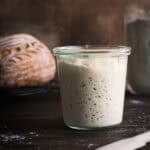Sourdough Starter Recipe
Every great sourdough loaf starts with a strong starter. All you need is flour, water, and a little patience. This guide walks you through a simple, step-by-step process to create and maintain your own sourdough starter using just all-purpose flour and water.
Servings: 1 Sourdough Starter
Equipment
- 7.5-oz glass jar optional
- rubber band optional
Ingredients
Day 1
- 14 grams all-purpose flour
- 14 grams water
Day 3
- 28 grams all-purpose flour
- 28 grams water
Days 4 to 7
- 14 grams sourdough starter
- 28 grams all-purpose flour
- 28 grams water
Levain
- 28 grams sourdough starter
- 56 grams all-purpose flour
- 56 grams water
Instructions
Day 1
- In a clean jar, mix flour and water14 grams all-purpose flour, 14 grams water
- Stir until the flour is hydrated.
- Cover loosely and let it sit at room temperature (ideally 75–80°F) for 24 hours.Find the warmest spot in your kitchen and keep your starter there while it’s developing. On top of your fridge, in the microwave, or inside the oven with just the light on are all great options.
Day 2
- Continue letting your starter ferment. The microbes in your culture are still settling in and balancing themselves out. You may stir it if you like, but it’s not necessary.
Day 3
- You should see some bubbles and a slight rise. It's ok if you don't see any activity. Time to refresh your starter. Add flour and water to the jar.28 grams all-purpose flour, 28 grams water
- Stir until the flour is hydrated.
- Cover loosely and let it sit at room temperature.
Days 4 to 6
- Transfer 14 grams of starter to a clean jar and throw out the rest.14 grams sourdough starter
- Add water and flour to the jar.28 grams all-purpose flour, 28 grams water
- Stir until no dry bits of flour remain.
- Cover loosely with a lid and place it in a warm place.
- Optional: Wrap a rubber band around your jar right after feeding to mark the level where your starter is at. It’s an easy way to track if your starter has risen.
- Repeat once a day every day.
- If your sourdough starter doesn't rise after day 6, don't worry. Continue feeding it until it doubles in volume after feeding.
Day 7
- You should see a noticeable rise in your starter. This is a great sign it’s ready to use! To test whether your starter is ready:Transfer starter to a clean jar. Discard the rest or store it in a separate container.14 grams all-purpose flour
- Add flour and water to the jar.28 grams all-purpose flour, 28 grams water
- Stir until no dry bits of flour remain.
- Cover loosely with a lid and place it in a warm place.
- Set a timer for 4 hours and check on whether your starter has doubled.
- If it rises consistently after feedings, it’s mature, healthy and ready to bake with!
How to get your starter ready for baking
- Transfer your starter to a larger jar and discard the rest.28 grams sourdough starter
- Add flour and water to the jar. Stir until no dry bits of flour remain.56 grams all-purpose flour, 56 grams water
- Let the starter ferment until doubled in volume, this could take about 4 to 8 hours.
- Once your starter doubles, it should be ready to use for up to 12 hours after feeding.
Notes
- If your kitchen is cold, fermentation will take longer. Try keeping your jar on top of the fridge or in the oven with the light on (but the oven off!).
- Funky smells in the beginning are normal. As your starter matures, the aroma will settle into something pleasantly tangy and yeasty.
- Once your starter is well established, you can store it in the fridge and feed it weekly or keep it on the counter and feed it daily.
- Don’t bake with your starter straight from the refrigerator. Give your sourdough starter a few feedings before using it in a recipe.
- If you forget to feed your starter for one day, don't worry! Just feed it when you remember and continue with the process.
- You may see a dark liquid forming on top of your starter during this period. This is called hooch! It's completely harmless and a sign that your starter needs to be fed. You can either stir it in or pour it out before feeding.
